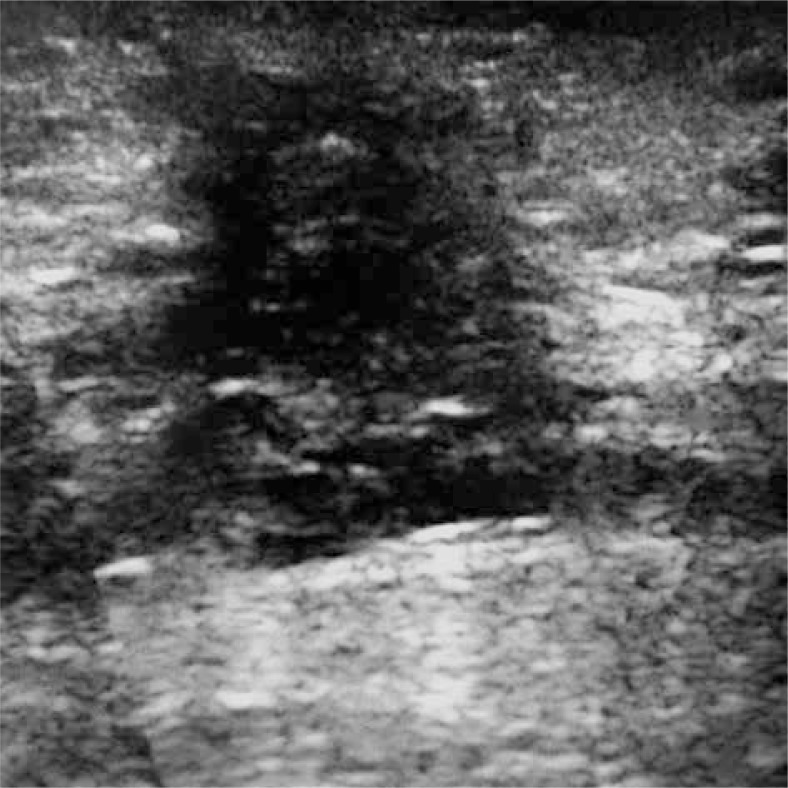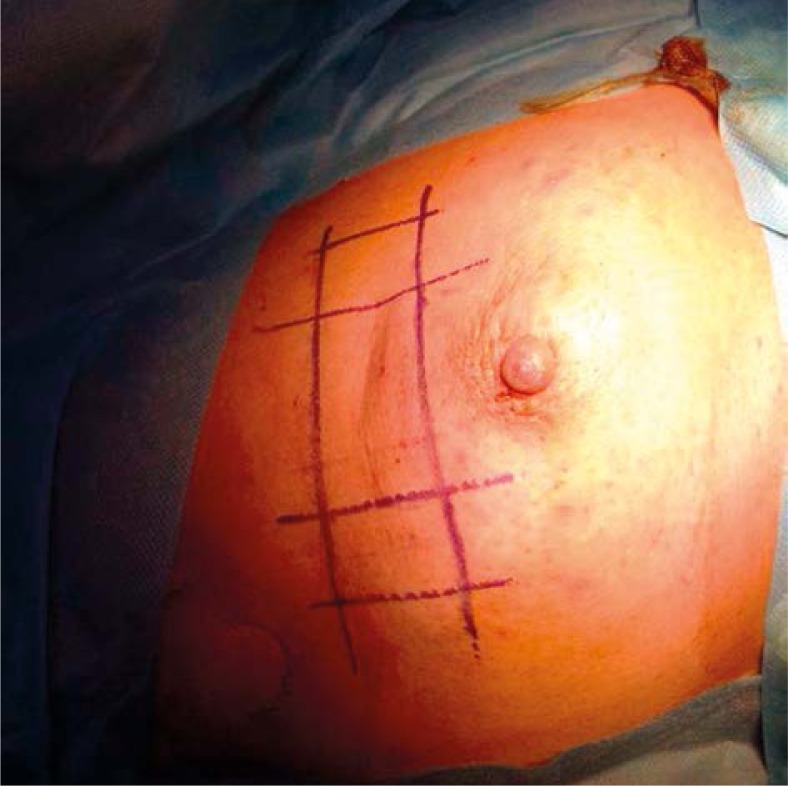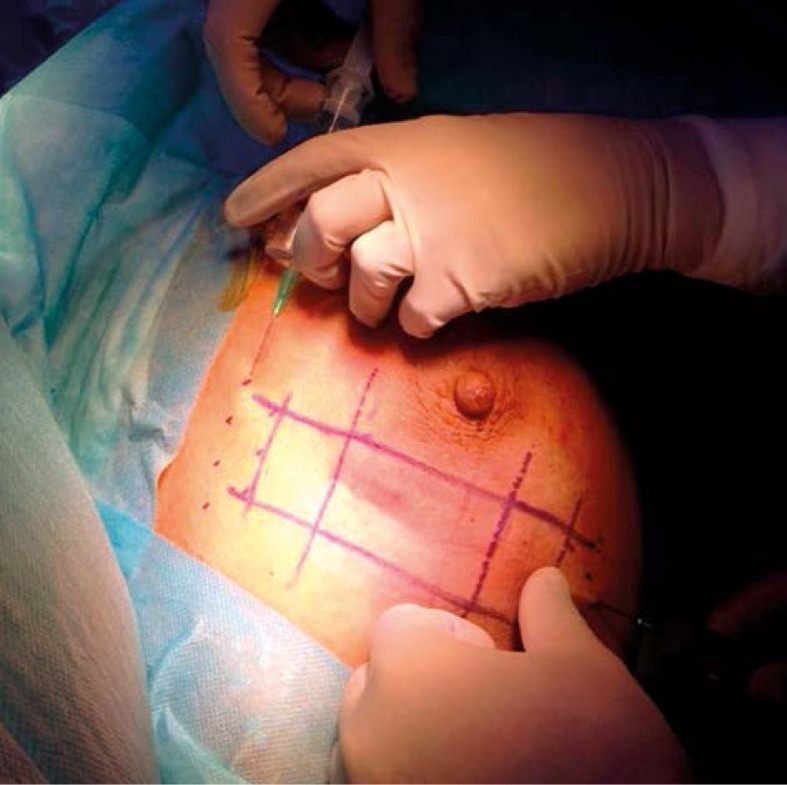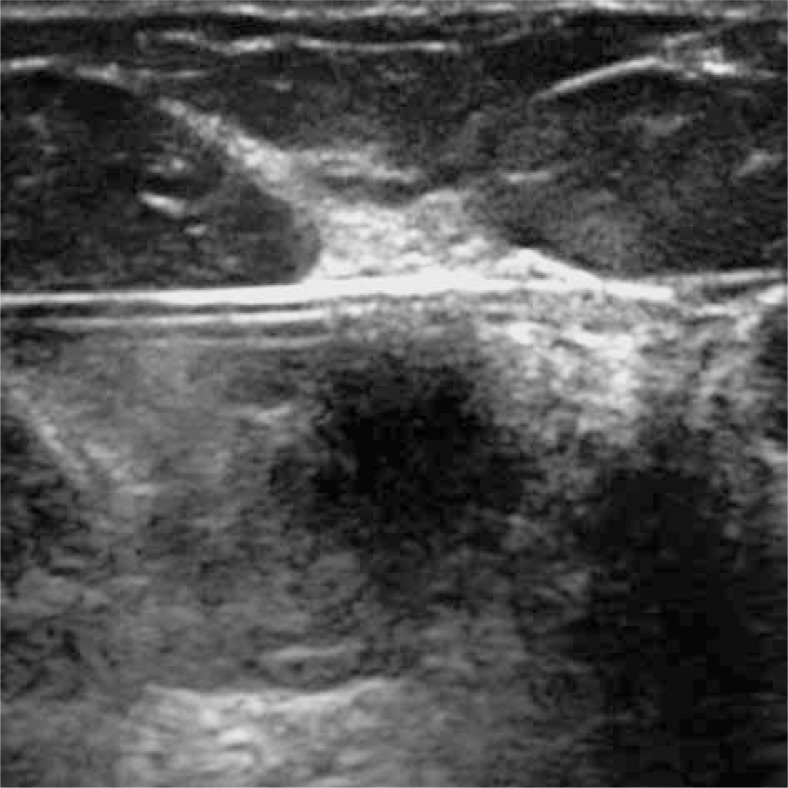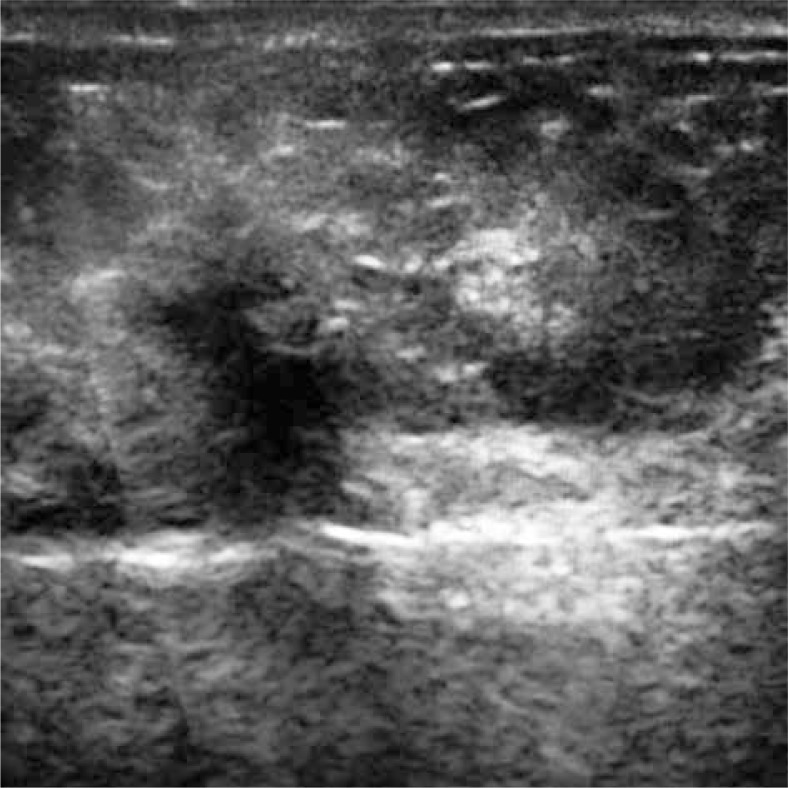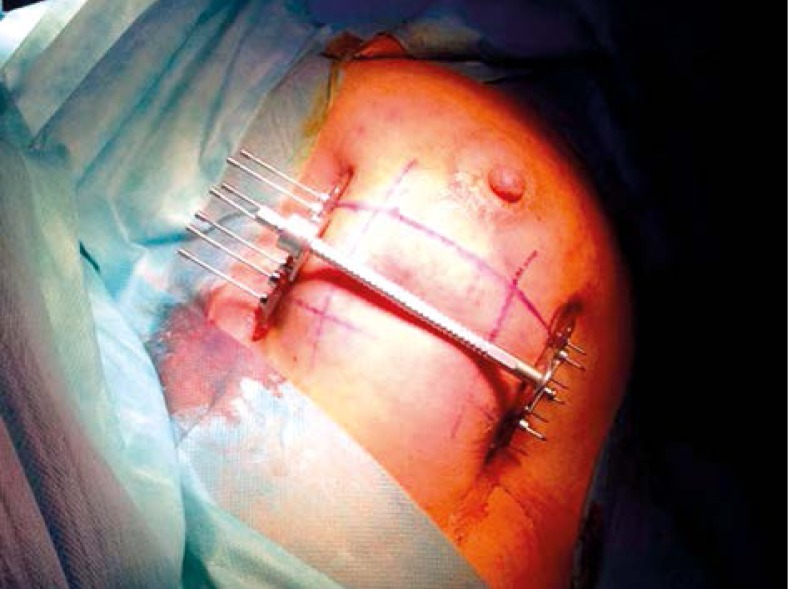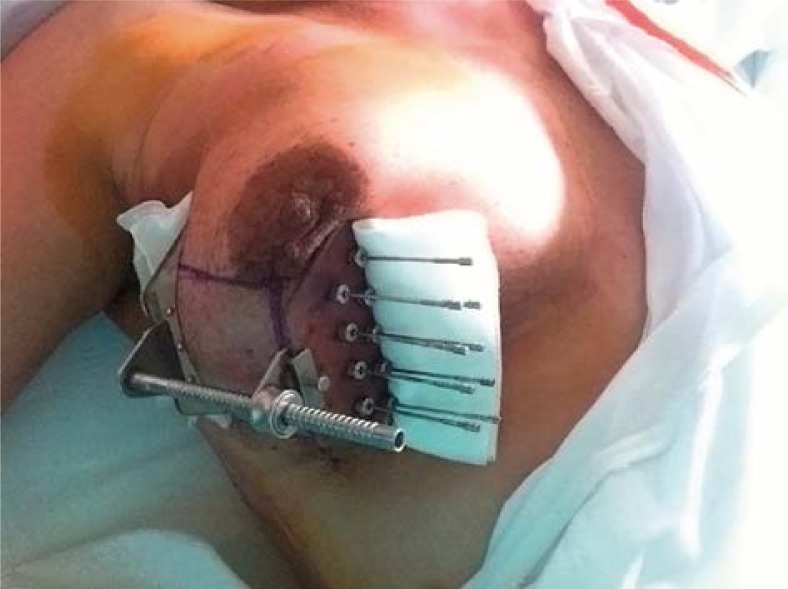Abstract
Purpose
To demonstrate the utility of a boost with interstitial brachytherapy (BT) in breast-conserving therapy (BCT) by doing a thorough review of the literature and describing in detail our technique for delivering this boost.
Material and methods
Our department has been delivering the boost with interstitial BT since 1989, in most cases with rigid needles and a theoretical dosimetry. In the early years, we used low-dose-rate (LDR) with iridium-192 wires. The dose administered was 15 Gy if there were no risk factors for local relapse or 20-25 Gy in the presence of risk factors. The risk factors considered were the presence of a close margin (less than 10 mm) and an extensive intraductal component (more than 25%). After 2002, we switched to high-dose-rate (HDR); using the linear quadratic model we changed the low dose to 3 fractions of 4.5 Gy in the case of no risk factors for local relapse or to 3 fractions of 5 Gy in the presence of risk factors.
Results
In 79 consecutive boost patients treated in our department between 2010 and 2011, with a median follow-up of 46 months, the local control rate was 97.47%. With respect to cosmesis, fibrosis occurred in 17 cases (21.5%) and hyperpigmentation in 26 cases (32.9%). Our hospital's results are comparable in terms of local control and cosmesis to those of other authors.
Conclusions
This educational article describes our department's boost technique with rigid needles and comments briefly on our results using this technique in a group of consecutively treated patients in our department. A review of the literature and the published results on local control and cosmesis is also described.
Keywords: brachytherapy, breast cancer, breast conserving therapy, interstitial boost
Purpose
In the conservative treatment of breast cancer, the utility of the boost has been clearly shown in several publications. Because of the trial design, the strongest publication is the boost versus no boost trial from the European Organisation for Research and Treatment of Cancer (EORTC) [1, 2]. Brachytherapy is an excellent way of delivering this boost, especially in patients at high risk for local recurrence [3]. A Hungarian randomized trial by Polgar et al. in 2002, also showed that a boost dose significantly improves local control, and that this is especially important for patients at high risk for local recurrence, such as patients with positive or close margin status, high mitotic activity index, and young age. Local control and cosmesis were shown to be excellent and similar in patients boosted with either high-dose-rate brachytherapy (HDR-BT) or electrons [4]. In our hospital, about 90% of patients diagnosed with breast cancer receive breast-conserving therapy (BCT). Every year we treat more than 600 patients with breast cancer, and after receiving 50 Gy to the whole breast they need a boost to the tumour bed. Our Brachytherapy Unit was opened in 1989, and since then we have frequently been treating patients with a BT boost. In the early years, we preferred to do the boost with an interstitial implant because we had limited access to the linacs. We needed the electrons from the linacs for head and neck patients, and therefore we only used electrons for the breast boost when BT could not be performed. Our experience in T1 breast tumours treated with 50 Gy to the whole breast plus a boost with low-dose-rate (LDR) 192Ir has already been published in 2000 [5]. Our department has extensive experience in this field and in this article we share our tips and tricks about how to perform the interstitial BT boost.
Material and methods
The external whole breast irradiation consists of 50 Gy to the isocenter or 45 Gy at 90% of the dose. We initially used the photons from 60Co and then from 1995 started using 6 MV photons from a linear accelerator, until January 2004, when we definitively closed our cobalt unit. For the boost, in the early years, we did not perform image-guided BT: to localize the tumour bed we considered the preoperative mammography, the position of the scar, the surgical report, and the patient's description if the nodule was palpable.
Brachytherapy was used in almost all cases, independent of whether the tumour bed location was deep or superficial. In patients with superficial tumour beds and small breasts, only one plane was used, in most cases with plastic tubes. The distance between needles was 1.8 cm and a plastic template in the shape of equilateral triangles was used. Low dose rate was used with 192Ir wires and the dose administered was 15 Gy, if there were no risk factors for local relapse or 20-25 Gy in the presence of risk factors. The risk factors considered were the presence of a close margin (less than 10 mm) and extensive intraductal component (more than 25%). Also for young women under 40 years, higher doses were usually administered. In 2002 the department switched to HDR. Using the linear quadratic model and previous Spanish experience (Guinot) [6] with an α/β ratio of 10 for the tumor and 3 for the skin and fat tissue, we obtained the dose we are delivering with HDR. This dose is 3 fractions of 4.5 Gy, equivalent to 16 Gy with electrons, if there are no risk factors for local relapse. In the presence of risk factors, this dose is 3 fractions of 5 Gy, equivalent to 20 Gy. The dose with HDR-BT is delivered in approximately 22 hours, the same timeframe in which LDR was delivered (at 0.5-0.7 Gy/h).
Today we are stricter with the eligibility criteria. The most suitable cases are patients with deep lesions in large breasts, but we also perform BT in small breasts, depending on the relationship between the cavity and the size of the breast. In the case of a small breast, a smaller implant would be performed using 5-7 needles, whilst in larger breasts 9 needles are usually used. With respect to the margin, 10 mm is considered a free margin, in which case we would administer 3 fractions of 4.5 Gy (equivalent to 16 Gy at 2 Gy/fractions with electrons). In the other cases, we would administer 3 fractions of 5 Gy (equivalent to a 20 Gy with electrons). If the margin is clearly affected by tumour, we would perform a margin re-excision to obtain free margins. The size of the cavity is clearly important. An ultrasound (US) is always performed before the implant to check if there is a seroma, and to identify the tumour bed if possible. If identified, the tumour bed is measured. The maximum length should be 6 cm, in order to include all the seroma with a “9 hole” template implant.
Nowadays, oncoplastic surgery is becoming more popular and many patients are treated with different techniques. In our center, the surgeons always mark the surgical bed with clips. We always consider the location of the clips in the dosimetry computed tomography (CT) and carefully read the surgical report. In oncoplastic surgery cases, there is typically no seroma present and BT is usually not performed due to the difficulty in localizing the tumour bed. It should be noted however, that it is also difficult to delineate the tumour bed for external beam radiotherapy (EBRT) in such cases.
In recent years, as the department has more electrons available, the following are also considered to evaluate if the patient is a good candidate for a BT boost: 1) the patient's general condition, co-morbidities and other factors such as anticoagulant intake or heparin use; 2) the patient's anatomy and the location of the surgical bed and the scar; 3) the CT scan for (EBRT) planning: the seroma can be clearly visualized in cases where a seroma exists; 4) the preoperative mammography; 5) an US is also performed during the course (of EBRT) to evaluate the seroma and the skin distance; the distance must ideally be greater than 1 cm. If there is no seroma, we consider if there is enough tissue to do the implant and if clips are present in the surgical bed margins.
At our institution we strongly believe that BT is the best way of delivering the boost because the dose-intensity is higher. Immediately after completing EBRT, 3 fractions of 4.5 or 5 Gy are administered in less than 24 hours. Thus, the overall treatment time is really shortened compared to those patients who receive 10 fractions of 2 Gy with electrons over a further 2 weeks. In addition, compared to EBRT, the treated volume with BT is smaller, and the use of CT and US ensures delivery of the boost to the tumor bed. The distribution of the isodoses delivered with BT is also different to the ones obtained with EBRT: higher doses (hot spots) are obtained in the tumour bed with a rapid fall-off, respecting the skin if the superficial plane is at least 1 cm under the surface. For all the above reasons we firmly believe in BT and try to perform it in all patients who are suitable candidates.
In the Brachytherapy Unit we have one dedicated operating theatre with an anaesthesiologist. Four or five procedures are performed in one day. Deep sedation is administered for the patient's comfort. Firstly, an US is performed to localize the tumour bed (Fig. 1) and project it on to the skin (Fig. 2); a marker is used to draw it, and then the template is leaned on to the patient's skin to mark the entrance and exit points in order to obtain a good geometric distribution. We try to leave at least 3 cm from the first point to the projection of the planning target volume (PTV). Local anaesthesia (2% Mepivacaine with a little bicarbonate) is injected at the entrance and exit points of every needle (Fig. 3). When doing the implant, the ultrasound is used continuously to find the seroma and check the position of every needle with respect to the seroma and to the skin. In cases without seroma, a CT is performed just before entering the operating theatre to look for the clips. We then try to surround the whole seroma with needles, always starting with the superficial plane. The first plane is inserted between the skin and the superficial part of the seroma (Fig. 4), and the deep plane under the seroma (Fig. 5). The free-hand technique is used for the superficial plane and the template is used to guide the rest of the implant. The distance to the skin and the pectoral muscle is checked with US. In most cases, a 2-plane implant is sufficient. Many other centers start with the deep plane, but using the US we are able to adjust any of the needles as necessary. Some centers use the free-hand technique, others always use a template. Some centers perform a CT before the implant and others use US; our instituion considers all techniques to be adequate, depending on the department experience.
Fig. 1.
Ultrasound to localize the tumour bed (seroma)
Fig. 2.
Projection of the seroma on the skin
Fig. 3.
Local anaesthesia in the entry and exit points of every needle
Fig. 4.
Needle of the first plane between the skin and the superficial part of the seroma
Fig. 5.
Needle of the deep plane under the seroma
The needles are not usually substituted for plastic tubes. Great care is taken to leave at least 1 cm between the superficial plane and the skin to avoid late toxicity in the form of telangiectasia. Metallic buttons are used to avoid longitudinal needle movement, and a metallic bridge is used to secure the needles (Figs. 6 and 7). In most cases, a theoretical dosimetry is done without CT scan. As the needles are metallic, we just measure the distance from the tip and the end of the needle to the PTV, and also the distance to the skin for every needle. We also check with US that there is more than 1 cm between the superficial plane and the skin.
Fig. 6.
Final picture of the rigid implant with the metallic bridge and the template
Fig. 7.
Picture of another implant in the outer quadrants
The Oncentra® planning system (Elekta Brachytherapy, Elekta AB, Stockholm, Sweden) is used and for the dosimetry a modified Paris System is used. Every patient receives 3 fractions of 4.5 or 5 Gy with HDR from a Microselectron HDR (Elekta Brachytherapy), separated by at least 6 hours. As our Brachytherapy Unit has 14 beds, the patient can stay in hospital overnight. The next morning the third fraction is given and after removal of the implant the patient is discharged.
Results
Since many of our patients come from different hospitals, we are unable to follow up all of them. However, for this study we have selected 79 consecutive patients who received their boost with BT in our department between June 2010 and June 2011 and attempted to perform a retrospective study looking at the clinical records of 4 different radiation oncologists. We considered any grade of hyperpigmentation or fibrosis that was described by the different physicians. In this group, we describe our results in terms of local control and cosmesis. The median follow-up period was 46 months (range 36-57) and the mean follow-up was 45.8 months. The median treated volume (V100) was 94.49 cc (range 35.8-190). At the end of the study, 8 patients had developed a relapse: 2 local relapses, 2 regional node metastases, and 7 distant metastases, resulting in a local control rate of 97.47%. Three patients died due to breast cancer at 15, 27 and 41 months.
With respect to cosmesis, fibrosis was observed in 17 cases (21.5%), hyperpigmentation in 26 cases (32.9%), asymmetry in 3 cases (3.8%), and telangiectasia in 1 case (1.3%). One patient developed fat necrosis and 1 patient achromia at the entrance and exit points of the BT needles. Of course these rates change over time and we have not and were not able to register them actuarially. Other side effects included a radiation pneumonitis in 1 patient, which was successfully treated with corticosteroids, 2 cases of mastitis, and 1 case of an abscess.
Complications can arise after BT, but these can usually be easily and successfully managed. Bleeding, either during insertion or removal of the needle, stops after compressing the area. Usually less than a minute of compression is enough, but in some cases up to 3 minutes of compression may be necessary. If the patient is taking antiaggregants, it is recommended to stop them 5 days before surgery. Oral anticoagulants should be substituted by heparin. If there is an infection, oral antibiotics should be administered for 2 weeks. Fat necrosis is a late complication that manifests as pain and inflammation of the surgical bed; it is a clinical diagnosis and infection must be ruled out. Fat neccrosis can also be identified on mammography. Management with oral anti-inflammatories for several weeks is usually effective treatment, although in some cases evacuation of the fat necrosis may be necessary.
Discussion
The use of an interstitial implant as a boost as part of BCT has been practiced for many years, especially in Europe. Van Limbergen describes the advantages of delivering the boost with BT in terms of improving local control, probably due to the increased dose to the tumour bed. He discusses in detail the technical aspects of breast BT that appear to be relevant for a high quality clinical outcome, especially with respect to the skin in order to obtain a good cosmetic result [7]. Many authors have described their results in terms of local control and cosmesis. In 2000, our department published our results for T1 tumours in 530 patients who were treated with whole breast irradiation up to 50 Gy and a BT boost [5]. The mean BT dose was 16.8 Gy. With a median follow-up of 39.5 months, the local control was 94.9% and 91.7% at 5 and 7 years, respectively. Univariate analysis demonstrated that age (older than 52 years), premenopausal status, moderate and high histological grades (grades II-III), and presence of intraductal comedocarcinoma were prognostic factors for local relapse. Multivariate analysis for local disease-free survival demonstrated that only perineural or muscular infiltration remained as prognostic factors. A tumour bed dose of 70 Gy or higher had a negative impact on breast subcutaneous fibrosis, whereas a dose rate lower than 65 cGy/h was better for skin colour at 2 years.
It is also known that BT is an excellent way of giving radiotherapy to a small volume. In the boost vs. no boost trial, with a boost of 16 Gy, the volume treated with BT was just 60 cc vs. 144 cc for electrons and 288 cc for photons [1]. The dose administered with BT was 15 Gy at a rate of 10 Gy/24 hours, and there was a median delay to administering the BT of 18 days, with a longer overall treatment time (54 vs. 48 days). It was evident that the rate of local relapse was even smaller in the BT group, despite a much smaller treatment volume and the longer overall treatment time. The differences, however, were not statistically significant. At 5 years, local recurrences were seen in 2.5% of the patients after an interstitial boost, in 4.8% of the patients who received an electron boost, and in 4% of the patients who received a photon boost. The grade of fibrosis in the whole breast as well as at the primary tumour bed was similar in the three groups. After a median follow-up period of 10.8 years, a boost dose of 16 Gy led to improved local control in all age groups, but no difference in survival [2]. During the 90's, a lot of studies have focused on the aesthetic results, looking at whether the cosmestic outcome was better with electrons or with BT [8–11], but it still remains a controversial issue [12, 13]. Few of these studies were randomized and most of them were a retrospective comparison between series even from different hospitals. This is reflected by Toboul et al. in 1995: in his study a small difference in cosmesis was noted in favour of patients that received an electron boost, but they received the EBRT to the whole breast with 4-6 MV photons from a linac; whilst the other group from another hospital received whole breast irradiation with 60Co and an 192Ir boost and had more axillary dissection. Interestingly, no differences in local control were found, despite the mean implanted volume being 31 cc with a mean delay of 26.6 days versus 118 cc with electrons after a mean delay of 5.5 days [9].
A prospective randomized study was published by Fourquet et al. in 1995, comparing an 192Ir implant boost with a 60Co EBRT boost to the primary tumour site, in 255 patients with tumours 3-7 cm in diameter, but in patients that were receiving definitive radiotherapy after a core biopsy only. The boost dose was 20 Gy in both groups. Cosmetic outcome in both groups was evaluated in 120 patients with a minimum 3-year follow-up and was comparable in both groups [14]. In 1997, Wazer et al. reported a prospectively applied boost dose escalation to the tumour bed and concluded that interstitial implant boost for breast conserving irradiation was associated with better cosmesis that EBRT boost, and that local control with implantation might be further enhanced by increasing implant volume and/or improved target localization [15].
In fact, no clear differences were actually found in any of the studies, as in the study from Perez et al., published in 1996. This study compared the results of the boost in 449 patients with T1 and T2 breast cancer treated with 9-12 MeV electrons versus 129 patients treated with an interstitial implant, 29 intraoperatively and 90 postoperatively. There was no significant difference in local tumour control, cosmesis or morbidity in patients treated with either electron beam or interstitial 192Ir implant boost [8]. The adoption of either of the boost techniques basically depends on department experience. Nowadays, the use of BT as a boost may be limited to patients, as described by Perez, with deeply seated target volumes in large breasts more than 4 cm below the skin, with microscopically positive or unknown margins not undergoing re-excision, or with other poor pathologic features such as extensive intraductal component [8]. Perez's study probably found no differences in local control according to the status of the margins because the patients with close or positive margins received a BT boost of 25 Gy.
In 1997, Vicini et al. reported their retrospective experience on 400 cases of stage I and II breast cancer, and also concluded that long-term local control and cosmetic outcome are excellent and similar in patients boosted with either electrons, photons or with LDR interstitial BT [16]. Frazier et al. reach the same conclusion in their study: no significant differences in the local recurrence rates or cosmetic outcome using electrons, photons, or an interstitial implant. On multivariate analysis, however, young age and margin status are found to be associated with increased local recurrence [17]. In 2010, Polgar et al. described their experience with HDR interstitial implant boost, either with rigid needles or plastic tubes [18]. After a median follow-up time of 94 months, only 7% ipsilateral breast failures were observed for a 5- and 8-year actuarial rate of 4.5% and 7.0%, respectively. Cosmetic outcome was rated excellent in 17%, good in 39%, fair in 33%, and poor in 11%. Grade 3 fibrosis and grade 3 telangiectasia occurred in 6.6% and 2.2% patients, respectively. In a univariate analysis, only positive margin status had a significant negative effect on local control. Guinot et al. have also published their results with 3 fractions of 4.4 Gy HDR in a series of 125 women with less than 5 mm or positive margins. The actuarial local control rate was 95.8% at 5 years and 91.1% at 9 years. Late fibrosis was the most common complication in 30% of patients, with good or excellent cosmetic results in 77% [6]. Resch et al. reported their results in a large retrospective cohort study of 410 women with early breast cancer treated with BCT including an interstitial BT boost. The treated volume was 104 cc for LDR-BT and 83 cc for HDR-BT. The 5- and 10-year actuarial local recurrence rates were 2% and 3.9%, respectively. Only age and menopausal status had significant impact on local control. Their conclusion was that the high-dose and large-volume interstitial BT appears to be superior to classical BCT without BT [19].
For the BT boost, the dose rate has been noted to relate to differences in cosmesis and local control by several authors, while some noted a higher incidence of breast recurrences with a dose rate less than 0.3 Gy/h. Mazeron et al. observed increased 5-year local tumour control with dose rates higher than 0.5 Gy/h [20]. Budrukkar et al. found that the type of tumour bed boost did not have a significant effect on cosmetic outcome, although there were significantly more late breast sequelae in women treated with single fraction HDR implants compared to LDR [21]. Harms et al., in a series of 113 patients, reported that PDR at 1 Gy/h is as effective as LDR for the boost [22]. Pieters et al. investigated the timing of the interstitial boost and concluded that the cosmesis was similar for the patients that received the boost per-operatively compared to the patients that received it after the EBRT [23].
One of the studies with the longest follow-up period is the one published by Hill-Kayser et al. in 2011. It is a matched 1: 1 study of 141 patients treated with whole breast radiotherapy followed by an 192Ir boost after breast-conserving surgery matched to patients treated with an electron boost. Twenty-year data demonstrated no difference in rates of local recurrence or patterns of failure between both groups. Better cosmesis was observed in the electron group 1 year after radiotherapy, with a trend continuing for 10 years. The incidence of complications was similar between the groups, with a trend towards increased fibrosis in patients receiving implant boost [24]. With a median follow-up of 46 months, the local control rate in our department's study is 97.47%. Our cosmetic results are fibrosis in 17 cases (21.5%) and hyperpigmentation in 26 cases (32.9%). These results are comparable in terms of local control and cosmesis to those from other authors.
A good conclusion to this discussion is the one from Hannoun-Levi: he suggests that only a phase III trial randomizing BT boost vs. electron therapy boost could show a possible improvement of local control rate in the BT arm. “However, this trial should enrol patients with a real high risk of local recurrence in order to take benefit from the dosimetric advantages of BT” [25].
Conclusions
We have described our department's technique for the boost with rigid needles and commented briefly on our results with this technique in a group of consecutively treated patients. We have also reviewed the literature and the results published on local control and cosmesis.
Disclosure
Authors report no conflict of interest.
References
- 1.Poortmans P, Bartelink H, Horiot JC, et al. The influence of the boost technique on local control in breast conserving treatment in the EORTC ‘boost versus no boost’ randomized trial. Radiother Oncol. 2004;72:25–33. doi: 10.1016/j.radonc.2004.03.007. [DOI] [PubMed] [Google Scholar]
- 2.Bartelink H, Horiot JC, Poortmans PM, et al. Impact of a higher radiation dose on local control and survival in breast-conserving therapy of early breast cancer: 10-year results of the randomized boost versus no boost EORTC 22881-10882 trial. J Clin Oncol. 2007;25:3259–3265. doi: 10.1200/JCO.2007.11.4991. [DOI] [PubMed] [Google Scholar]
- 3.Ulutin HC, Ash D, Dodwell D. Brachytherapy boost to the tumour bed in high risk patients after limited surgery for breast cancer. Clin Oncol. 2003;15:156–159. doi: 10.1053/clon.2002.0187. [DOI] [PubMed] [Google Scholar]
- 4.Polgár C, Fodor J, Orosz Z, et al. Electron and high-dose-rate brachytherapy boost in the conservative treatment of stage I-II breast cancer first results of the randomized Budapest boost trial. Strahlenther Onkol. 2002;78:615–623. doi: 10.1007/s00066-002-1053-1. [DOI] [PubMed] [Google Scholar]
- 5.Moreno F, Guedea F, Lopez Y, et al. External beam irradiation plus (192)Ir implant after breast-preserving surgery in women with early breast cancer. Int J Radiat Oncol Biol Phys. 2000;48:757–765. doi: 10.1016/s0360-3016(00)00676-3. [DOI] [PubMed] [Google Scholar]
- 6.Guinot JL, Roldan S, Maroñas M, et al. Breast-conservative surgery with close or positive margins: can the breast be preserved with high-dose-rate brachytherapy boost? Int J Radiat Oncol Biol Phys. 2007;68:1381–1387. doi: 10.1016/j.ijrobp.2007.01.055. [DOI] [PubMed] [Google Scholar]
- 7.Van Limbergen E. Indications and technical aspects ofbrachytherapy in breast conserving treatment of breast cancer. Cancer Radiother. 2003;7:107–120. doi: 10.1016/s1278-3218(03)00015-5. [DOI] [PubMed] [Google Scholar]
- 8.Perez CA, Taylor ME, Halverson K, et al. Brachytherapy or electron beam boost in conservation therapy of carcinoma of the breast: A nonrandomized comparison. Int J Radiat Oncol Biol Phys. 1996;34:995–1007. doi: 10.1016/0360-3016(95)02378-x. [DOI] [PubMed] [Google Scholar]
- 9.Touboul E, Belkacemi Y, Lefranc JP, et al. Early breast cancer: influence of type of boost (electrons vs iridium-192 implant) on local control and cosmesis after conservative surgery and radiation therapy. Radiother Oncol. 1995;34:105–113. doi: 10.1016/0167-8140(95)01508-e. [DOI] [PubMed] [Google Scholar]
- 10.Taylor ME, Perez CA, Halverson KJ, et al. Factors influencing cosmetic results after conservation therapy for breast cancer. Int J Radiat Oncol Biol Phys. 1995;31:753–764. doi: 10.1016/0360-3016(94)00480-3. [DOI] [PubMed] [Google Scholar]
- 11.van Limbergen E, van den Bogaert W, van der Schueren E, Rijnders A. Tumour excision and radiotherapy as primary treatment of breast cancer. Analysis of patient and treatment parameters and local control. Radiother Oncol. 1987;8:1–9. doi: 10.1016/s0167-8140(87)80016-6. [DOI] [PubMed] [Google Scholar]
- 12.Hammer J, Mazeron JJ, Van Limbergen E. Breast boost-why, how, when...? Strahlenther Oncol. 1999;175:478–483. doi: 10.1007/s000660050057. [DOI] [PubMed] [Google Scholar]
- 13.Polgár C, Fodor J, Major T, et al. The role of boost irradiation in the conservative treatment of stage I-II breast cancer. Pathol Oncol Res. 2001;7:241–250. doi: 10.1007/BF03032380. [DOI] [PubMed] [Google Scholar]
- 14.Fourquet A, Campana F, Mosseri V, et al. Iridium-192 versus cobalt-60 boost in 3-7 cm breast cancer treated by irradiation alone: final results of a randomized trial. Radiother Oncol. 1995;34:114–120. doi: 10.1016/0167-8140(94)01492-l. [DOI] [PubMed] [Google Scholar]
- 15.Wazer DE, Kramer B, Schmid C, et al. Factors determining outcome in patients treated with interstitial implantation as a radiation boost for breast conservation therapy. Int J Radiat Oncol Biol Phys. 1997;39:381–393. doi: 10.1016/s0360-3016(97)00325-8. [DOI] [PubMed] [Google Scholar]
- 16.Vicini FA, Horwitz EM, Lacerna MD, et al. Long-term outcome with interstitial brachytherapy in the management of patients with early-stage breast cancer treated with breast-conserving therapy. Int J Radiat Oncol Biol Phys. 1997;37:845–852. doi: 10.1016/s0360-3016(96)00606-2. [DOI] [PubMed] [Google Scholar]
- 17.Frazier RC, Kestin LL, Kini V, et al. Impact of boost technique on outcome in early-stage breast cancer patients treated with breast-conserving therapy. Am J Clin Oncol. 2001;24:26–32. doi: 10.1097/00000421-200102000-00004. [DOI] [PubMed] [Google Scholar]
- 18.Polgár C, Jánváry L, Major T, et al. The role of high-dose-rate brachytherapy boost in breast-conserving therapy: Long-term results of the Hungarian National Institute of Oncology. Rep Pract Oncol Radiother. 2010;15:1–7. doi: 10.1016/j.rpor.2010.01.002. [DOI] [PMC free article] [PubMed] [Google Scholar]
- 19.Resch A, Pötter R, Van Limbergen E, et al. Long-term results (10 years) of intensive breast conserving therapy including a high-dose and large-volume interstitial brachytherapy boost (LDR/HDR) for T1/T2 breast cancer. Radiother Oncol. 2002;63:47–58. doi: 10.1016/s0167-8140(02)00022-1. [DOI] [PubMed] [Google Scholar]
- 20.Mazeron JJ, Simon JM, Crook J, et al. Influence of dose rate on local control of breast carcinoma treated by external beam irradiation plus Iridium 192 implant. Int J Radiat Oncol Biol Phys. 1991;21:1173–1177. doi: 10.1016/0360-3016(91)90273-7. [DOI] [PubMed] [Google Scholar]
- 21.Budrukkar AN, Sarin R, Shrivastava SK, et al. Cosmesis, late sequelae and local control after breast-conserving therapy: influence of type of tumour bed boost and adjuvant chemotherapy. Clin Oncol. 2007;19:596–603. doi: 10.1016/j.clon.2007.06.008. [DOI] [PubMed] [Google Scholar]
- 22.Harms W, Krempien R, Hensley FW, et al. 5-year results of pulsed dose rate brachytherapy applied as a boost after breast-conserving therapy in patients at high risk for local recurrence from breast cancer. Strahlenther Onkol. 2002;178:607–614. doi: 10.1007/s00066-002-0977-9. [DOI] [PubMed] [Google Scholar]
- 23.Pieters BR, Hart AA, Russell NS, et al. A comparison in cosmetic outcome between per-operative interstitial breast implants and delayed interstitial breast implants after external beam radiotherapy. Radiother Oncol. 2003;67:159–164. doi: 10.1016/s0167-8140(03)00034-3. [DOI] [PubMed] [Google Scholar]
- 24.Hill-Kayser CE, Chacko D, Hwang WT, et al. Long-term clinical and cosmetic outcomes after breast conservation treatment for women with early-stage breastcarcinoma according to the type of breast boost. Int J Radiat Oncol Biol Phys. 2011;79:1048–1054. doi: 10.1016/j.ijrobp.2009.12.026. [DOI] [PubMed] [Google Scholar]
- 25.Hannoun-Lévi JM, Marsiglia H. Brachytherapy boost for breast cancer: what do we know? Where do we go? Cancer Radiother. 2004;8:248–254. doi: 10.1016/j.canrad.2004.07.002. [DOI] [PubMed] [Google Scholar]



